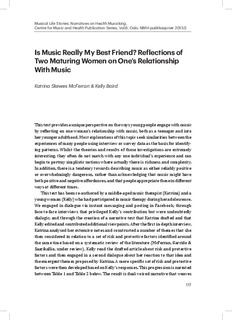| dc.contributor.author | McFerran, Katrina Skewes | |
| dc.contributor.author | Baird, Kelly | |
| dc.date.accessioned | 2014-06-24T13:13:55Z | |
| dc.date.available | 2014-06-24T13:13:55Z | |
| dc.date.issued | 2013 | |
| dc.identifier.citation | I: Musical life stories : narratives on health musicking, s. 117-138 | nb_NO |
| dc.identifier.isbn | 978-82-7853-081-8 | |
| dc.identifier.issn | 1893-3580 | |
| dc.identifier.uri | http://hdl.handle.net/11250/196704 | |
| dc.description.abstract | This text provides a unique perspective on the ways young people engage with music by reflecting on one woman’s relationship with music, both as a teenager and into her younger adulthood. Most explorations of this topic seek similarities between the experiences of many people using interview or survey data as the basis for identifying patterns. Whilst the theories and results of these investigations are extremely interesting, they often do not match with any one individual’s experience and can begin to portray simplistic notions where actually there is richness and complexity. In addition, there is a tendency towards describing music as either reliably positive or overwhelmingly dangerous, rather than acknowledging that music might have both positive and negative affordances, and that people appropriate these in different ways at different times. This text has been co-authored by a middle-aged music therapist (Katrina) and a young woman (Kelly) who had participated in music therapy during her adolescence. We engaged in dialogue via instant messaging and posting in Facebook; through face-to-face interviews that privileged Kelly’s contribution but were undoubtedly dialogic; and through the creation of a narrative text that Katrina drafted and that Kelly edited and contributed additional viewpoints. After the first in-depth interview, Katrina analysed her extensive notes and constructed a number of themes that she then considered in relation to a set of risk and protective factors identified around the same time based on a systematic review of the literature (McFerran, Garrido & Saarikallio, under review). Kelly read the drafted article about risk and protective factors and then engaged in a second dialogue about her reaction to that idea and the emergent themes proposed by Katrina. A more specific set of risk and protective factors were then developed based on Kelly’s responses. This progression is narrated between Table 1 and Table 2 below. The result is dual-voiced narrative that weaves the general and the specific, and that potentially reminds us that music and people are complex systems that relate over time in both predictable and unexpected ways. | nb_NO |
| dc.language.iso | eng | nb_NO |
| dc.publisher | Norges musikkhøgskole | nb_NO |
| dc.relation.ispartofseries | Centre for Music and Health Publication Series;Vol:6 | |
| dc.relation.ispartofseries | NMH-publikasjoner;2013:5 | |
| dc.subject | VDP::Humaniora: 000::Musikkvitenskap: 110::Musikkterapi: 113 | nb_NO |
| dc.title | Is music really my best friend? : reflections of two maturing women on one's relationship with music | nb_NO |
| dc.type | Chapter | nb_NO |
| dc.type | Peer reviewed | nb_NO |
| dc.source.pagenumber | S. 117-138 | nb_NO |
